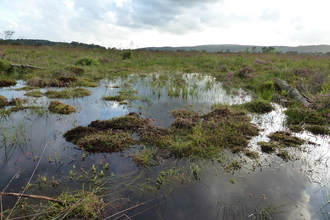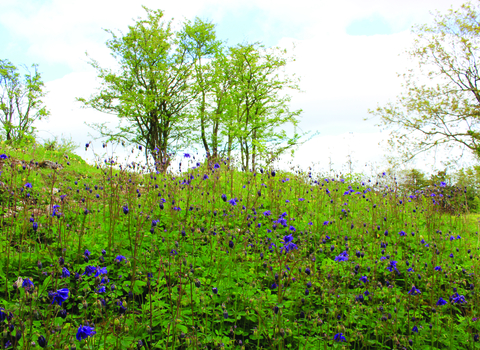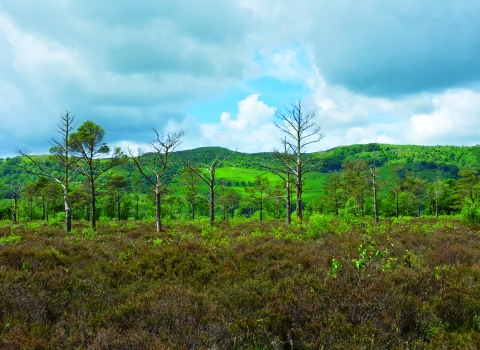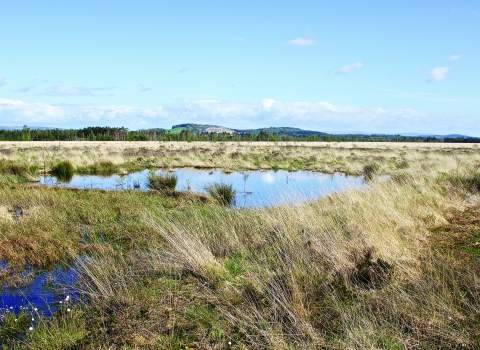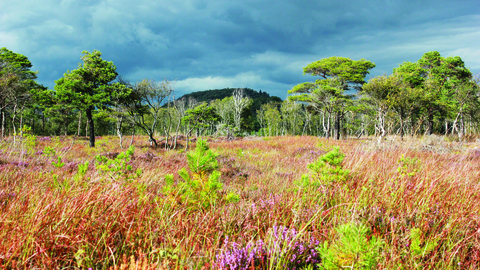
Meathop Moss Nature Reserve near Witherslack
Location
Know before you go
Dogs
When to visit
Opening times
Open all year roundBest time to visit
April to AugustAbout the reserve
Wildlife highlights
- Vibrant green hairstreak butterflies and emperor moths can be seen in May and early June, followed by the uncommon large heath butterfly from late June to early August.
- In winter, look out for snipe, whose camouflage makes them invisible until they fly up from under your feet in a distinctive zig-zag flight. Also listen for the whistling call of teal from the pools near the entrance.
- Enjoy a myriad of dragonflies and damselflies, and listen for bog bush-crickets.
A prized peatland
Meathop Moss has been a nature reserve since 1919 when the Society for the Promotion of Nature Reserves first leased the site.
Despite drainage of the surrounding land, it remains a remarkable example of a raised mire and the Trust has undertaken significant work to maintain a high water table.
Removing trees, blocking drains and creating bunds all contribute to retaining water, which is essential for the range of unusual plants to succeed, and ultimately continue forming peat.
This nature reserve is an internationally rare lowland raised peatbog. High and stable water levels are essential to the health and long term future of the bog.
Over thousands of years, dead plant material forms peat and the bog grows, however peat formation ceases if the bog becomes too dry.
Unfortunately this bog has suffered in the past from a steady lowering of water levels and a gradual deterioration of the peatland and its wildlife.
What makes Meathop Moss so special?
Sphagnum mosses, sundews, bog-rosemary, bog asphodel and cross-leaved heath create a colourful carpet that’s speckled with the white heads of cottongrass in early summer. These specialist plants draw over 200 species of butterfly and moth.
Rich in insects
In May and early June green hairstreak butterflies and emperor moths can be seen. The uncommon large heath butterfly flies from late June to early August.
Another day-flying moth, the northern eggar, is also active at this time. The caterpillars of this species are black and orange and very hairy.
The uncommon bog bush cricket and a variety of dragonflies and damselflies also occur. Over 200 species of butterfly and moth have been recorded.
Other animals
Snipe, stonechat and tree pipit are often seen on the open moss. Red and roe deer, and adder are also present on the nature reserve.
Keeping it special
Management at Meathop Moss is aimed at retaining as much water as possible on the bog to enable peat formation to continue. This involves removing trees and blocking any drainage ditches.
The Trust has also purchased some of the adjacent farmland and raised water levels here.
In partnership with Natural England, the Trust has been carrying out significant habitat restoration works which aim to raise water levels and secure the long term future of the Moss.
Conifer trees have been removed from around the edges as they have served to dry the peat. Excavators have worked to block drains and create small low bunds that retain water on the bog.
We are aware that this work and rising water levels have caused some disruption to access routes onto the Moss. It was necessary to remove sections of boardwalk for instance and rising water levels have made the normal access route unusable.
We have therefore installed temporary safe access onto the reserve at present and ask you to take care when entering onto the Moss.
We are also now in the planning phase of creating and installing new access routes, walkways and signage and hope that these will be completed in the near future.
The Trust thanks you for your patience and hopes you enjoy your visit to this wonderful and unusual nature reserve.
Recent history
The nature reserve was purchased by the Trust in 1998 with help from the Heritage Lottery Fund.
Getting here
By car:
From A590 at Witherslack take the minor road signed for Ulpha (opposite the turning for Witherslack village). Approx 0.9km/0.5 miles from the junction just before High Stock Bridge park in the layby on the right-hand side where a track to the Moss leads off the road. Please do not obstruct field gates or the track. Follow the track then walk around the edge of the field to get onto the reserve.
By bicycle:
The reserve is on National Route 70 Walney to Wear (W2W) and National Route 700 The Bay Cycleway/Regional Route 30.
By public transport:
Buses run from Barrow-in-Furness, Ulverston, Newby Bridge, Grange-over-Sands and Kendal to Witherslack.
Species
Habitat
Contact us
Environmental designation
Did you know?
The Society for the Promotion of Nature Reserves later became the Wildlife Trusts.
Upcoming events at Meathop Moss Nature Reserve
If there are any upcoming events at Meathop Moss Nature Reserve we'll show them to you below.

Support our conservation work on this nature reserve,
and protect Cumbria's wildlife & wild places.




